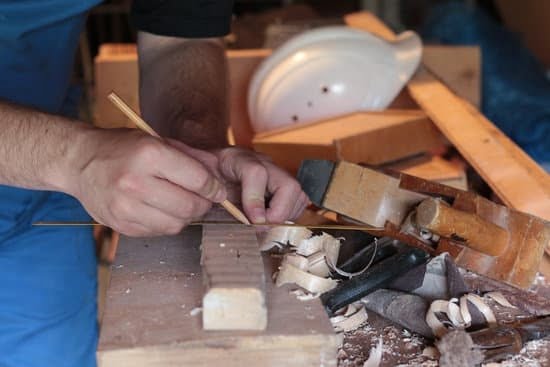Having a good vacuum system in a woodworking shop is crucial for maintaining cleanliness, safety, and productivity. Woodworking generates a considerable amount of dust and debris, which can lead to health hazards and hinder the efficiency of operations. In this introductory section, we will explore the significance of a vacuum in woodworking and how it can improve the overall working environment.
One of the main reasons why a vacuum is essential in woodworking is improved safety. Wood dust can be combustible and pose fire hazards if not properly controlled. A high-quality vacuum system helps extract the fine particles and prevents them from accumulating on surfaces or being inhaled by workers. Additionally, by removing dust from workspaces and equipment, the risk of accidental slips or falls is reduced.
Furthermore, air quality is another aspect that benefits greatly from effective vacuuming in woodworking shops. The constant production of wood dust can cause respiratory problems among workers if proper precautions are not taken. A reliable vacuum system removes airborne particles, ensuring that the air remains clean and breathable within the workspace.
In addition to safety and air quality, a good vacuum also plays a vital role in maximizing productivity in a woodworking shop. Dust collection significantly reduces cleanup time between tasks, allowing woodworkers to focus more on their craft. By keeping work areas tidy and eliminating distractions caused by accumulated debris, workflow efficiency is enhanced.
In summary, having an efficient vacuum system in a woodworking shop is crucial for several reasons – safety, air quality, and productivity. By properly collecting dust particles generated during woodworking activities, vacuums not only contribute to healthier working conditions but also promote smoother workflow processes. As we delve into this article further, we will explore different types of vacuums available for woodworking purposes and discuss specific factors to consider when selecting the ideal one for your needs.
Different Types of Vacuums for Woodworking
Introduction to the Types of Vacuums
When it comes to selecting a vacuum for your woodworking shop, understanding the different types available is essential. Each type has its own strengths and weaknesses, making it important to choose the one that best fits your specific needs. In this section, we will delve into the various options commonly used in woodworking shops and provide an overview of their features and capabilities.
Shop Vacuums
One popular choice for woodworking shops is the shop vacuum, also known as a wet-dry vacuum. Shop vacuums are versatile and can handle both dry debris and liquids, making them suitable for a wide range of tasks beyond just woodworking. They typically come with various attachments such as crevice tools and brush heads, allowing you to clean different surfaces effectively. However, shop vacuums may not have specialized features designed explicitly for woodworking purposes.
Dust Extractors
Dust extractors are specifically designed for capturing fine dust particles produced during woodworking processes. These vacuums typically feature high-performance filters that can capture even the smallest particles to maintain good air quality in the workshop. Dust extractors often come equipped with larger capacity bins or collection bags to accommodate heavier dust volumes. They may also have specialized attachments such as expandable hoses and floor sweepers to optimize dust collection efficiency.
Central Vacuum Systems
For larger woodworking operations or workshops with multiple machines, central vacuum systems offer a comprehensive solution. These systems consist of a powerful centralized unit connected through a network of ducts to individual machines. The advantage of a central vacuum system is that it provides simultaneous dust collection from multiple machines without needing separate vacuums for each one. This approach ensures efficient dust extraction throughout the workspace while minimizing noise pollution.
It’s important to note that these are just three common types of vacuums used in woodworking shops. Other options, such as portable dust collectors and air filtration systems, may also be suitable depending on your specific requirements. Consider the size of your workshop, the type of woodworking tasks you undertake, and any additional features or attachments you may need when making your selection.
Evaluating the Suction Power of a Woodworking Vacuum
When it comes to selecting a vacuum for your woodworking shop, evaluating the suction power is crucial. Suction power refers to the strength of the vacuum’s airflow, which determines its ability to collect and remove dust and debris from the shop environment. To ensure efficient dust collection in a woodworking space, it is essential to understand how to measure and evaluate suction power.
One way to measure suction power is by looking at the air watts (AW) rating of a vacuum. Air watts signify the amount of suction power that a vacuum can produce. Generally, higher air wattage indicates stronger suction capability. However, it’s important to note that other factors also contribute to effective dust collection, such as the design of the vacuum’s intake and overall airflow efficiency.
In terms of evaluating suction power for woodworking purposes, there are some minimum requirements to consider. For efficient dust collection in a woodworking shop, experts recommend a minimum of 125 AW or above. The higher the AW rating, the better the vacuum’s ability to capture fine particles like wood dust effectively.
Aside from air watts, there are additional factors to consider when assessing the suction power of different vacuum models. These include the diameter and length of hoses used with the vacuum and any additional attachments or features specifically designed for woodworking tasks. A wide diameter hose can help maintain high airflow and reduce clogging in a woodworking environment where large volumes of debris are common.
By understanding how to evaluate suction power properly and considering these factors, woodworkers can select a vacuum with adequate capability for their specific needs. Efficient dust collection not only keeps your shop clean but also ensures a healthier and safer working environment by minimizing potential health hazards associated with airborne wood particles.
Considerations for Dust Collection Efficiency
Dust collection is a crucial aspect of woodworking shop maintenance, as it not only helps keep the workspace clean but also plays a significant role in ensuring the health and safety of woodworkers. Efficient dust collection systems minimize airborne dust particles, reducing the risk of respiratory issues and protecting equipment from damage caused by dust buildup. In this section, we will explore the considerations for optimizing dust collection efficiency in woodworking vacuums.
The Importance of Efficient Dust Collection
Efficient dust collection is essential for maintaining a clean and healthy woodworking environment. Woodworking involves various processes that generate substantial amounts of fine dust particles, such as cutting, sanding, and planing. These particles can not only create a mess but also pose serious health hazards when inhaled over time.
In addition to health concerns, inadequate dust collection can lead to reduced productivity in a woodworking shop. Dust accumulation on work surfaces and equipment hampers precision and efficiency during tasks. It can also affect the performance and lifespan of machinery if dust is allowed to settle inside motors or other internal components.
Features Enhancing Dust Collection Efficiency
When considering a vacuum for woodworking purposes, it is vital to look for specific features that enhance its dust collection efficiency. One such feature is a cyclone separator that helps separate larger debris from fine dust particles before they reach the filter system. This prevents clogging and ensures optimal suction power throughout operation.
Another important feature to consider is micron filtration. A high-quality vacuum with micron filtration captures even the smallest dust particles before releasing clean air into the shop environment. Look for filters with HEPA (High-Efficiency Particulate Air) ratings or other industry certifications to ensure effective filtration.
It is worth noting that while these features contribute to better dust collection efficiency, regular maintenance remains essential. Filters should be cleaned or replaced as recommended by the manufacturer to optimize their effectiveness over time. Additionally, sealing any gaps or leaks in the dust collection system will prevent dust from escaping into the shop, further enhancing the overall efficiency of the system.
Noise and Size Considerations in Woodworking Vacuums
When it comes to woodworking vacuums, noise and size are important factors to consider. The woodworking environment can already be quite noisy, with power tools and machinery running constantly. Having a vacuum that adds to the noise level can be distracting and uncomfortable for woodworkers. Therefore, selecting a quiet vacuum is essential for creating a more pleasant working experience.
One option to minimize noise is by choosing a vacuum with a lower decibel rating. Look for vacuums that have sound insulation or noise reduction features built-in. Additionally, models with a brushless motor tend to be quieter compared to those with brushed motors. Reading customer reviews and product specifications can help determine the noise level of different vacuum models.
In addition to noise considerations, the size of the vacuum is another crucial factor when choosing one for a woodworking shop. Woodworking spaces often have limited space available, so opting for a compact yet powerful vacuum is important. Portable vacuums allow for easy mobility around the workshop and can reach areas that may be difficult to access without moving other equipment.
Fortunately, there are many vacuums specifically designed for smaller spaces in woodworking shops. Look for lightweight models that have ergonomic handles or carrying straps for convenience. Compact shop vacuums or dust extractors are commonly used in woodworking spaces due to their effectiveness and portability.
By selecting a quiet and appropriately sized vacuum, woodworkers can create a more comfortable working environment while ensuring efficient dust collection at the same time. Prioritizing these considerations will contribute to an overall safer and healthier woodworking shop.
- Choose a vacuum with a low decibel rating
- Look for models with sound insulation or noise reduction features
- Consider vacuums with brushless motors
- Select compact and lightweight models
- Opt for portable vacuums with ergonomic handles or carrying straps
Maintenance and Longevity of Woodworking Vacuums
Proper maintenance is crucial in ensuring the longevity and optimal performance of a woodworking vacuum. By following these guidelines, you can extend the lifespan of your equipment and ensure that it continues to function effectively for years to come.
- Regular Cleaning: It is essential to clean your woodworking vacuum regularly to prevent dust and debris build-up, which can affect its suction power and overall performance. Start by emptying the collection bag or canister after each use. Use a soft brush or cloth to remove any dust or residue from the external surfaces. Additionally, check the cleaning instructions provided by the manufacturer for any specific recommendations.
- Filter Changes: The filters in your woodworking vacuum play a critical role in trapping fine particles and preventing them from being released back into the air. Over time, these filters can become clogged, reducing the efficiency of your vacuum. Therefore, it is important to follow the manufacturer’s guidelines on filter replacement intervals and install new filters when necessary.
- Proper Storage: When not in use, store your woodworking vacuum in a clean and dry location. Ensure that it is protected from extreme temperatures or excessive moisture, as these conditions can damage sensitive components over time. Consider investing in storage solutions such as vacuum covers or carrying cases specifically designed for woodworking vacuums.
- Availability of Replacement Parts: When choosing a woodworking vacuum, consider opting for a brand that provides easy access to replacement parts. Over time, certain components may wear out or break down due to regular use. Being able to easily find and replace these parts will prevent you from having to replace the entire unit unnecessarily.
5. Maintenance Hacks and Tips: Here are some additional tips to help you keep your woodworking vacuum performing optimally:
- Clean or replace brushes on attachment tools regularly.
- Check hoses for any blockages or damage.
- Lubricate moving parts as recommended by the manufacturer.
- Avoid overheating by allowing your vacuum to cool down after prolonged use.
By following these maintenance guidelines, you can ensure that your woodworking vacuum remains in excellent condition and provides efficient dust collection for all your woodworking projects. Remember, regular maintenance not only extends the lifespan of your vacuum but also contributes to a clean and safe working environment.
Budget Considerations and Value for Money in Woodworking Vacuums
There are a wide range of budgets when it comes to woodworking vacuums, and it’s important to find the right balance between cost and quality. When considering budget for a woodworking vacuum, it is essential to not only look at the upfront cost but also the long-term value for money.
Some inexpensive options may seem attractive initially, but they may not provide the necessary suction power or durability required for efficient dust collection in a woodworking shop. On the other hand, investing in a high-quality vacuum with advanced features may come at a higher price, but it can ultimately save money in terms of maintenance and replacement costs.
When determining the value for money in woodworking vacuums, it is crucial to consider factors such as suction power, dust collection efficiency, noise level, size/portability, and overall durability. These considerations will ensure that you are getting the most out of your investment while also meeting your specific needs and requirements. Additionally, looking for vacuums that offer longer warranties or have readily available replacement parts can contribute to their value for money.
| Vacuum Model | Price | Suction Power (CFM) | Noise Level (dB) |
|---|---|---|---|
| Brand X Shop Vacuum | $150 | 120 CFM | 85 dB |
| Brand Y Dust Extractor | $300 | 150 CFM | 75 dB |
| Brand Z Central Vacuum System | $700 | 200 CFM | 65 dB |
Please note that these prices and specifications are for illustrative purposes only and may vary depending on the manufacturer and retailer.
It’s important to evaluate your budget, prioritize your needs, and do thorough research before making a decision. Reading customer reviews and testimonials from reputable sources can also provide valuable insights into the performance, durability, and overall value of different woodworking vacuum models. By carefully considering your budget and selecting a vacuum that offers excellent value for money, you can ensure that you have an efficient and reliable tool in your woodworking shop.
Real-life Reviews and Recommendations for Woodworking Vacuums
When it comes to finding the perfect vacuum for your woodworking shop, real-life reviews and recommendations from fellow woodworkers can provide valuable insights and guidance. Hearing from those who have firsthand experience with different vacuum models can help you make an informed decision and choose a vacuum that best suits your needs. In this section, we will share personal experiences, pros and cons, as well as customer ratings and reviews from reputable sources.
One highly recommended vacuum for woodworking shops is the Festool CT 26 E HEPA Dust Extractor. This dust extractor is known for its exceptional performance and high-quality construction. Users praise its strong suction power that effectively collects even fine dust particles. The HEPA filter ensures excellent air quality by capturing particles down to 0.3 microns in size, making it suitable for individuals with respiratory sensitivities or allergies.
Another popular option is the Shop-Vac 5989300 Wet/Dry Vacuum Cleaner. This versatile vacuum is ideal for both wet and dry applications and is well-suited for woodworking tasks. Its powerful motor provides robust suction, allowing efficient collection of wood chips, shavings, and other debris. Users appreciate its durable build quality and ease of use.
For those seeking a more budget-friendly option without compromising on performance, the Craftsman CMXEVBE17595 Wet/Dry Vac is often recommended. This vacuum boasts a large capacity tank capable of holding up to 16 gallons of debris. It features an impressive air power delivery of 170 CFM (cubic feet per minute), which facilitates effective dust collection in a woodworking environment.
It’s important to note that while customer reviews are helpful in guiding your decision-making process, personal preferences may vary based on individual needs or specific woodworking tasks. Therefore, researching multiple sources of feedback and considering factors like suction power, noise levels, size/portability, filtration efficiency, and durability will ultimately lead to finding the perfect vacuum for your woodworking shop.
Conclusion
In conclusion, having a good vacuum system is essential for any woodworking shop. Throughout this article, we have discussed the importance of a vacuum in woodworking, the different types of vacuums available, evaluating suction power, considerations for dust collection efficiency, noise and size considerations, maintenance and longevity, budget considerations and value for money, as well as real-life reviews and recommendations.
Selecting the perfect vacuum for your woodworking shop requires careful consideration of these factors. It is crucial to prioritize safety, air quality, and overall productivity by investing in a vacuum that can effectively collect dust and debris. Consider the specific needs of your woodworking tasks and workspace when comparing different types of vacuums such as shop vacuums, dust extractors, or central vacuum systems.
When evaluating suction power, measure it according to the requirements for efficient dust collection in your woodworking shop. Take into account additional factors such as filtration capabilities and industry standards or certifications that ensure high dust collection efficiency. Noise pollution can also impact your working experience, so opt for quieter vacuums.
Maintenance is key to prolonging the lifespan of your woodworking vacuum. Follow guidelines on regular cleaning, filter changes, and proper storage to keep it performing optimally. Look for reputable brands that offer availability of replacement parts.
Budget constraints should be balanced with desired features and performance when selecting a vacuum. Seek high-quality options that offer the best value for money in terms of both initial investment and potential long-term cost savings.
Frequently Asked Questions
What vacuum should I use for woodworking?
When it comes to choosing a vacuum for woodworking, there are a few factors to consider. First and foremost, you’ll want a vacuum that can handle fine dust particles efficiently. Look for one with a high-quality filtration system to prevent clogging and ensure that the dust doesn’t escape back into the air.
Additionally, opt for a vacuum with strong suction power as woodworking often generates large amounts of debris. A shop vac specifically designed for woodworking with features like cyclonic action or specialized attachments may be a good option as well, as they are built to handle the unique demands of workshop environments.
Is 3.5 HP enough for shop vac?
Whether 3.5 HP is enough for a shop vac depends on your specific needs and the tasks you plan to accomplish in your workshop. In general, 3.5 HP can provide sufficient suction power for most common woodworking applications, such as collecting sawdust or cleaning up small to medium-sized messes.
However, if you’re dealing with heavier debris or require extraction over larger areas, you might benefit from a more powerful shop vac with higher horsepower ratings. Consider the size of your workspace and the type of materials you typically work with when determining whether 3.5 HP will meet your requirements.
Can I use a normal vacuum in a workshop?
While it’s technically possible to use a normal household vacuum cleaner in a workshop setting, it’s not recommended due to several reasons. Regular vacuum cleaners are usually not designed to cope with the fine dust particles and potentially larger debris generated by woodworking activities. This can lead to clogging or damage to the internal components of the vacuum over time.
Furthermore, workshop environments often have higher levels of dust and other particulates that can quickly accumulate in standard vacuum cleaner filters, reducing their overall effectiveness and potentially compromising their performance in other areas of your home where they may be used later on. It’s best to invest in a dedicated shop vac or an industrial-grade vacuum designed specifically for workshop use to ensure efficient cleaning and longevity of the vacuum.

Hi everyone! I’m a woodworker and blogger, and this is my woodworking blog. In my blog, I share tips and tricks for woodworkers of all skill levels, as well as project ideas that you can try yourself.





